Scroll Down To Order
Scroll Down To Order
A flicker of hope
is all that stood
. . . against barbarism.
Another outbreak of such a crisis of madness
[meaning the First World War]
would necessarily involve the destruction of
society in the public order. June 1, 1933
People cried out
for a better future.
Germany neither intends nor wishes
to interfere in the internal affairs
of Austria or to conclude an Anschluss. May 1935
If the problem is solved,
there will be no further territorial damands
in Europe by Germany. Sep 1938
CASTLES OF THE MIND ... VENTURE ACROSS ALL BRIDGES
—1944—
Time Capsule Dates of 1944, one of the Anniversary years of the Second World War.


Nazi Germany had conquered most of Europe and North Africa during the early days of WW II, however, things changed by 1944. The following is taken from the book A Toast For You and Me, America's Participation, Sacrifice and Victory, vol 7, which is available. Above is 8th A. F. pilot Lt. Colonel Francis S. Gabreski 56th Fighter Group which produced 39 aces, 3rd highest behind 354th Group (9th A.F.) and 357th (8th A.F.) respectively 43 and 41. Both the pilot and the Southern Pacific steam locomotive, which pulled the Daylight streamlined train across the western United States, were tops in their class. He was the highest ace in the 56th with 28 kills; the engined is called the most beautiful engine in the world, up to this day. The 1940s were the Age of Steel and Streamline Era.
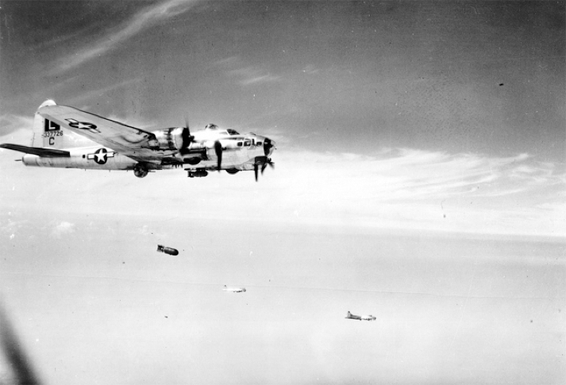
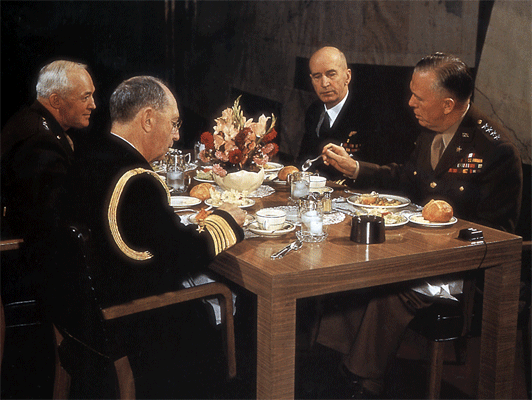
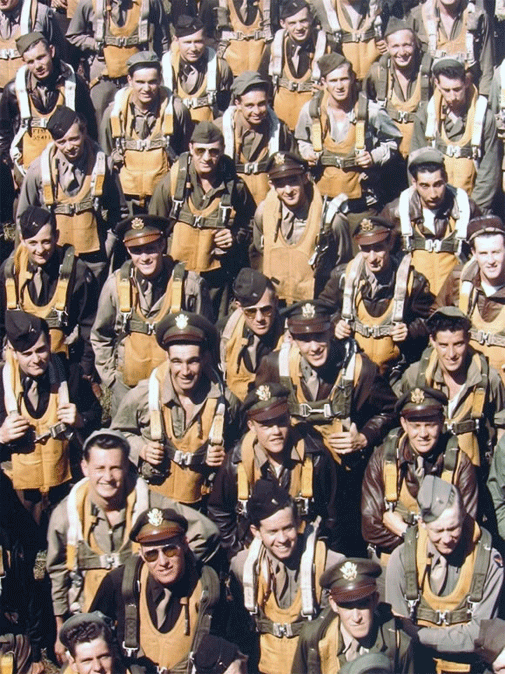
The attack was filmed in b & w from the air by Japanese airmen. Ensign Kazuo Sakamaki became the first Japanese Prisoner of War after escaping from his mini-sub.
—1944—
Jan 1 1944 —Gen. Jimmy Doolittle assigned to command U.S. 8th Air Force in England.
Jan 15 1944 —U.S. force in Great Britain numbers 750,000.
Jan 16 1944 —Gen. Dwight D. Eisenhower assumes command as Supreme commander of Allied Forces in Europe.
Jan 20 —U.S. 36th Infantry Div attacks across Rapido River.
Jan 22 —Allied landings on Anzio attempts to outflank Gustav Line.
Jan 26 —Force of over 200 U.S. fighters and bombers knock out key Japanese airbase on Rabaul.
Feb 7 —Glenn Miller’s band makes smashing debut in U.K. press
Feb 20 —Big Week commences: 880 U.S. 8th A.F. bombers (and 835 fighters) drop 2218 tons of bombs on industrial centers at Leipzig, Gotha, Brunswick, Tutow, Oschersleben, Rostok, and Bernberg, Germany; over 200 Americans missing in action.
Feb 23 —Southern Pacific direct train service to Los Angeles resumed after a big storm in Southern California. 100 war plants were closed by power outages caused by the storm that killed four.Feb 24 —Exactly 1746 tons hit aricraft production centers at Gotha, Schweinfurt, Rostock, and Eisenach by 746 B-17's and B-24's of the 8th A.F. protected by 767 "little friends" U.S. fighter pilots shoot down 39 interceptors; 49 U.S. heavies lost, 10 fighters lost (over 433 Americans missing in action.) British carrier "Furious" makes raid on Norweigian coast. Chile crushes a vast Nazi spy ring. An American in the RAF. press
Feb 25 —First low-level strafing mission by U.S. 8th A.F. One thousand heavies of U.S. 8th and U.S. 15 A.F.'s bomb Regensburg, Stuttgart, Augsburg, Furth and other assembly plants; over 300 Americans missing in action.
Mar 4 —Six hundred B-17's and B-24's of U.S. 8th A.F. conduct first daylight raid on Berlin proclaims radio; only 30 U.S. B-17's actually bomb Berlin.
Mar 6 —Marines land on west coast of NewBritain Island. Colossal air battle over Berlin takes place; 69 U.S. 8th A.F. bombers missing in action out of 600 plus. Major train center Trappes, France, devastated by R.A.F. night bombing.
Mar 8 —Exactly 539 heavily escorted bombers of U.S. 8th A.F. bombard Berlin; 1060 tons fall; 891 U.S. fighters flew mission. 382 Americans missing in action. 78 interceptors knocked off by U.S. fighters.
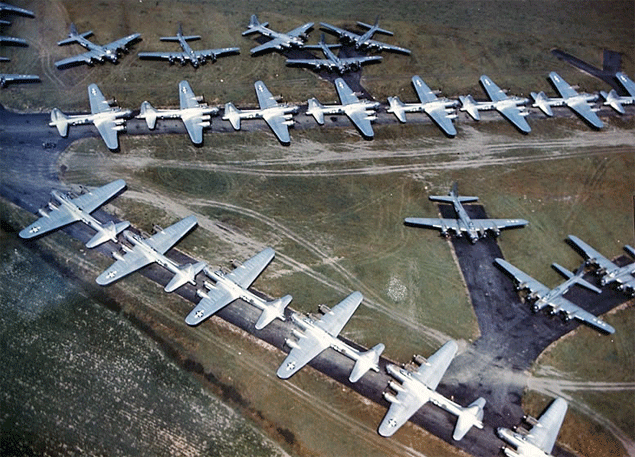
Mar 9 —Berlin, Hanover, Brunswick, Nauen bombed by 489 8th A.F. bombers; 83 Lightnings, 572 Thunderbolts, 153 Mustangs give support; 64 Americans missing in action. Deep in the Persian Gulf Servie Command, American railroaders performing a miracle for the Russian Army. One hardly ever hears about those Americans.
Mar 12 —Announcement is made of special trans-Atlantic aerial freight line innaugurated by 8th A.F. Service Command in England to supplement ATC (Air Transport Command) shipments, for top-secret Operation Overlord.
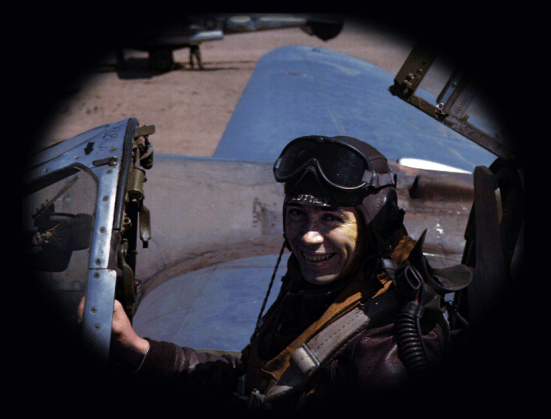

Mountain warfare in the Italian Front. Upper right is the remains of Monte Cassino. Audio report, things did not begin to change on the ground until late May. The Italian Front on the ground was still pretty dismal.
Mar 17 —New Zealanders take Cassino railroad station. U-boat sinks U.S. troopship Dempo in Mediterranean Sea. U.S. troops capture Lorengau airstrip, Admiralty Is.
Mar 18 —Steaming waves of lava bubble over Mt Vesuvius, Italy, in an opposite flow from a USAAF bombardment group base; lava buries several villages. New Zealand armor turned back with heavy losses at Cassino. Allied casualty list from January 16, 1944 to end of March 1944 in Italy was a horrible 52,130 (22,219 were American; 22,092 British and other Allies.).
Mar 26 —Over 500 8th A.F. bombers strike V-1 rocket sites in Cherbourg and Pas de Calais, France; 51 Americans missing in action.
Mar 27 —U.S. 8th bombs nine German airdromes in central and s.w. France, some targets almost to the Spanish border. Escorted by Belgian and Czech Spitfires, U.S. 9th A.F. Marauders hit Pas de Calais.

Unbelievable a it may sound, at nearly the same time troops and machines of every description was being sent over to England, in Italy the air war was starting to increase at a mighty pace. Mind you, the heavy bombers(15th A.F.) hit by daylight northern Italy while the tactical (12th A.F.) began central Italy on a definitive air campaign, dubbed Operation Strangle. It was also a British accomplishment but their numbers were low as they were being amassed mainly for Overlord. It was an incredible time to be alive. People at home were still building, building. This is what people at home heard.

The attack was filmed in b & w from the air by Japanese airmen. Ensign Kazuo Sakamaki became the first Japanese Prisoner of War after escaping from his mini-sub.
Apr 1 —Attacks against Hitler's rail network in the Balkans begin to reach full tilt, by U.S. 15th A.F. and MTO R.A.F. U-boat 218 lays mines off San Juan, Puerto Rico.
Apr 3 —Disrupting major supply artery on the Easten Front, 268 B-24s hit Budapest's railway yards, gateway to the Balkans. U.S. initiates heavy air campaign on Hollandia. U.S. completes air campaign over Carolines, lose 26 planes but destroy 115 enemy aircraft.
Apr 8 —U.S. 8th A.F. bombs central Germany, 363 Americans missing in action; 82 interceptors downed by fighter pilots.
Apr 9 —U.S. 8th raids aircraft plants in the Eastern Front, at Poznain and Gdynia, Poland. 10 B-17s crash land in southern Sweden.
Apr 10 —First TV telecast of a movie "Patrolling the Ether" is televised simultaneously on WNBT of N.Y.C. and WRGB of Schenectady, NY.
Apr 16 —U.S. 15th A.F. bombs Brasnov, giant railroad center between Budapest and Bucharest --1460 freight cars and 10 engines destroyed--Turnu Severin and Ploesti oil refineries. Red Air Force bombs river port and rails at Galati. R.A.F. bombs river port Turnu Severin by night.
May 23 —U.S. Fifth Army advances out of Anzio aided by Allied air interdiction operation.
May 25-26 —U.S. troops occupy Cisterna and Velletri at the foot of the extinct volcanoes, leaving the Sacco-Liri Valley.
May 27 —Fierce fighting engulfs U.S. Fifth Army at Artena.
May 30, 1944 On this date seventy years ago, there are 1,526,965
Americans in Britain. Allied troops were under tight security, no passes or leaves. In man's entire history there has never been a greater combined air, sea and land operation.
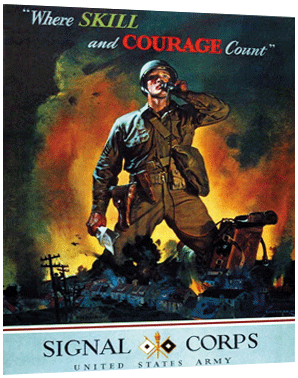
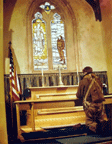
May 31 —U.S 36th Inf Div seize key radio outpost near Monte Artemisio to help pierce Caesare Line.
June 2—First Allied shuttle mission from Italy to the Ukraine is conducted; the three new American bases are at Poltava, Morgorod, and Piryatin. Persian Gulf Command U.S. assistance for the other side of the world.
L audio, supply line to Italian Front; R audio, supplies for Russian Front through the Persian Gulf Command.
June 3—OPA begins investigation of hotel over-pricing violations nationwide. A message at 4:39 p.m. slips out to U.S. and Latin American hemispheres on an AP teletype from London: Flash! Eisenhower’ headquarters announces Allied landings in France (it is false news.) Over 1000 Allied bombers raid Calais, Boulogne, the Chartres airport and n.w. France by daylight.
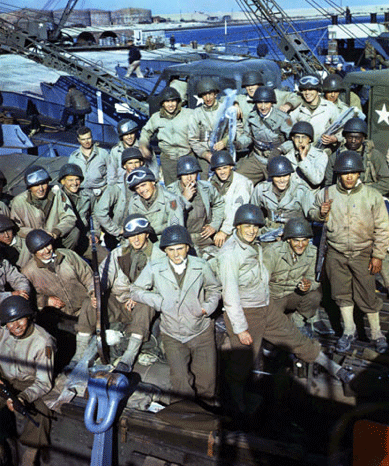
Amassing for D-Day. This picture was taken before the bad weather set in circa June 2??.
June 4—Rome falls to the Allies, and is the first European war capital liberated by the Allies. On initiative action by Capt. Daniel Gallery on board the USS Guadalcanal, U-505 is captured 150 miles west of Cape Blanco, French West Africa, U-505’s codebooks and an enigma are captured; the U-boat is the only one captured by a U.S. vessel in WW II. The capture of the U-505 was one of the best kept secrets of WW II. General Eisenhower postpones D-Day by 24 hours. ETO press release publicly proclaims the oil offensive. All through Sunday, June 4, the weather over England was terryfying as a wild storm tossed the waters and the rain fell and the winds grew in fury.
June 5—Gen. George C Marshall receives the Order of Suvorov, First Class, of the Soviet Union. B-29’s fly from China.
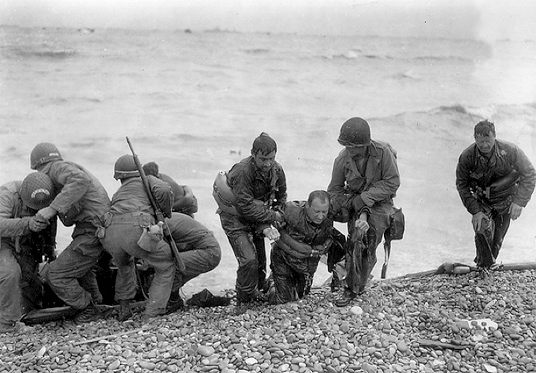
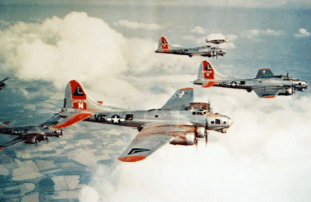
June 3—OPA begins investigation of hotel over-pricing violations nationwide. A message at 4:39 p.m. slips out to U.S. and Latin American hemispheres on an AP teletype from London: Flash! Eisenhower’ headquarters announces Allied landings in France (it is false news.) Over 1000 Allied bombers raid Calais, Boulogne, the Chartres airport and n.w. France by daylight.
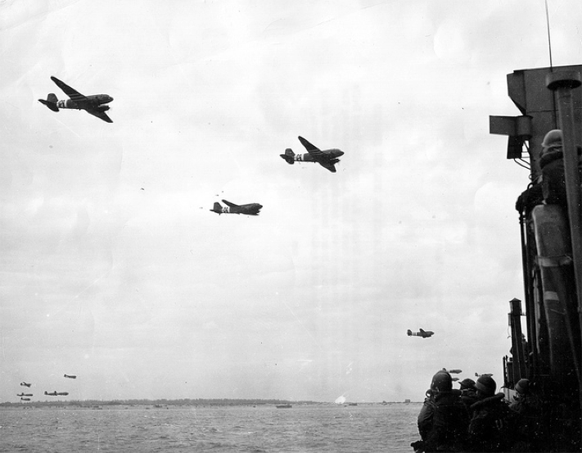
June 6—Allied Armies storm the Normandy beaches on D-Day, a force of 185,000 troops, 18,000 paratroopers, 13,175 aircraft, 4,066 landing ships and 20,000 vehicles are involved initially. One thousand nine hundred and 66 fighters provide escort protection. The U.S. 82nd and 101st Airborne drop behind the beaches between Ste Mére-Eglise, Carentan, and St Martin de Varreville.
4:30 a.m. (All times are British Double Summer Time). Sainte Mére-Eglise, in spite of shoot outs in town, is the first French town liberated by the Americans, though the night is still masked by fog.
5 a.m. Sky trains draped in black camouflage begin landing, more than 400, in towed lines of 50 per train. Some 3,500 gliders would be overall utilized by the Allies.
5:15 a.m. Field Marshal von Rundstedt comes to the conclusion the parachute drops are a prelude to a beach-landing, but no one in Berlin appreciates his orders. On his own secretly orders the 12th SS and the Panzer Lehr to the coast.
by 6 a.m. German naval command warns the 7th Army HQ in Le Mans, France, that for over an hour eerie radar blimps have been reported and are mounting in both the Pas de Calais and Normandy areas. Hitler’s HQ is warned via naval channels but, no one dares to wake up Der Fuehrer about the impending troubles.
6:50 a.m. The first 3,000 of the U.S. 1st Army gather towards the French coast. In approximately 8 short mins, sunrise.
7 a.m. People on the German-occupied coast of Normandy that live within 21.7 miles of any part of the coast are warned repeatedly by the BBC to evacuate.
7:30 a.m. American feet and hands begin touching French soil as the 16th and 116th Regimental Combat teams on Omaha and the 8th Inf Regiment on Utah touch; the American invasion has landed on schedule. Heavy enemy artillery and machine gun fire on Omaha. On Utah minimal opposition; 26 out of 30 first wave tanks reach the beach. Altogether 40 landing craft attempt the assault waves ashore.
8 a.m. German barriers are above water; it is low tide on Omaha, LCM’s and LCI’s pictured overturned in ocean area at Omaha Beach. LCVP’s loaded with GI’s circle aimlessly, because the navy managing the boats can not find the gaps which they had been told would be blown in the barriers. They had not been blown because many demo experts were either killed or landed on the wrong sector; the marker poles that came in initially were to be placed to guide landing craft through the gaps were destroyed when the boat carrying them was hit by German fire. LC doors are opened prematurely. Tanks are let out. The rough waters slap the little landing craft like if they were nothing. The rough waters rip the air inflated canvas donuts covering amphibian tanks. These special Sherman tanks were sealed watertight. The tank crews had oxygen masks with ten minutes’ supply of oxygen. Of the first 32 launched, 30 become inundated. Sands from the higher elevated dunes to the bluffs are all mined. The Germans are holed in the bluffs, and from one high church tower, with telescopic binoculars, Germans are able to pinpoint fire. Along with the troops are brave American reporters and cameramen, 28 scattered in all: Don Whitehead, Associated Press; John O'Reilly, New York Herald Tribune; Jack Thompson, Chicago Tribune; John MacVane, NBC; Bob Capa, Life Magazine; photographer Bert Brandt, Acme Newspictures; Charles Wertenbaker, Life Magazine; Tommy Grandin, the Blue Network, foretunner to ABC; Richard Stokes, St. Louis Post Dispatch; Warren Kenneth, Newark News; Lou Azrael, Baltimore News Post; Tom Treanor, Los Angeles Times; and Ernie Pyle were at Omaha. On Utah Beach were Larry SeSueur, CBS; Bob Dunnett, BBC; Henry Gorrell, United Press; Clark Lee, INS; Bill Stoneman, Chicago Daily News; Harold Austin, Sydney Morning Herald; and Bob Landry, Life photographer. Airborne reporters were Will Walton, Time Magazine; Phil Bucknell, Stars and Stripes (who broke his leg near Sainte Mere-Eglise) and Wright Bryan of NBC. Colleague Peter Paris, Yank correspondent, was on Omaha; he was hit by a bomb and died instantly. ABC’s George Hicks was on board the ship that also had Pyle and General Bradley. It was the general’s command ship, and he Hick’s made a famous recording on June 6, at 7:20 that became the only usable recording from the invasion fleet, however, it was not heard till midnight.
6:50 a.m. The first 3,000 of the U.S. 1st Army gather towards the French coast. In approximately 8 short mins, sunrise.
7 a.m. People on the German-occupied coast of Normandy that live within 21.7 miles of any part of the coast are warned repeatedly by the BBC to evacuate.
7:30 a.m. American feet and hands begin touching French soil as the 16th and 116th Regimental Combat teams on Omaha and the 8th Inf Regiment on Utah touch; the American invasion has landed on schedule. Heavy enemy artillery and machine gun fire on Omaha. On Utah minimal opposition; 26 out of 30 first wave tanks reach the beach. Altogether 40 landing craft attempt the assault waves ashore.
8 a.m. German barriers are above water; it is low tide on Omaha, LCM’s and LCI’s pictured overturned in ocean area at Omaha Beach. LCVP’s loaded with GI’s circle aimlessly, because the navy managing the boats can not find the gaps which they had been told would be blown in the barriers. They had not been blown because many demo experts were either killed or landed on the wrong sector; the marker poles that came in initially were to be placed to guide landing craft through the gaps were destroyed when the boat carrying them was hit by German fire. LC doors are opened prematurely. Tanks are let out. The rough waters slap the little landing craft like if they were nothing. The rough waters rip the air inflated canvas donuts covering amphibian tanks. These special Sherman tanks were sealed watertight. The tank crews had oxygen masks with ten minutes’ supply of oxygen. Of the first 32 launched, 30 become inundated. Sands from the higher elevated dunes to the bluffs are all mined. The Germans are holed in the bluffs, and from one high church tower, with telescopic binoculars, Germans are able to pinpoint fire. Along with the troops are brave American reporters and cameramen, 28 scattered in all: Don Whitehead, Associated Press; John O'Reilly, New York Herald Tribune; Jack Thompson, Chicago Tribune; John MacVane, NBC; Bob Capa, Life Magazine; photographer Bert Brandt, Acme Newspictures; Charles Wertenbaker, Life Magazine; Tommy Grandin, the Blue Network, foretunner to ABC; Richard Stokes, St. Louis Post Dispatch; Warren Kenneth, Newark News; Lou Azrael, Baltimore News Post; Tom Treanor, Los Angeles Times; and Ernie Pyle were at Omaha. On Utah Beach were Larry SeSueur, CBS; Bob Dunnett, BBC; Henry Gorrell, United Press; Clark Lee, INS; Bill Stoneman, Chicago Daily News; Harold Austin, Sydney Morning Herald; and Bob Landry, Life photographer. Airborne reporters were Will Walton, Time Magazine; Phil Bucknell, Stars and Stripes (who broke his leg near Sainte Mere-Eglise) and Wright Bryan of NBC. Colleague Peter Paris, Yank correspondent, was on Omaha; he was hit by a bomb and died instantly. ABC’s George Hicks was on board the ship that also had Pyle and General Bradley. It was the general’s command ship, and he Hick’s made a famous recording on June 6, at 7:20 that became the only usable recording from the invasion fleet, however, it was not heard till midnight.
8:30 a.m. After a 2 hour naval and air bombardment, in their sector from 7 miles out, British and Canadian assault troops begin to land on Normandy. Thirty-one of 40 tanks reach Sword Beach. Six out of 40 Royal Marine tanks make it ashore. Twenty out of 24 landing craft in the Canadian secto are lost. All key exits on Utah are secured by U.S. paratroopers.
9:20 a.m. General Bradley receives a radio signal from Colonel Talley, U.S. Deputy Chief of Staff V Corps: Such vehicles and armor as have reached the beach cannot advance any further while the German guns remain intact. They have to be silenced at any cost. U.S. and British Navies begin firing their superguns.
9:25 a.m. The entire Nazi controlled Fr radio network goes off the air.
9:45 a.m. It is known the U.S. VII Corps had landed 2000 yards south of their original sector on Utah encountering light enemy opposition. Tiny German crawling electronic weapons that resemble midget tanks, try to blow up Yanks on Utah, but are dismantled. On Omah nothing is a piece of cake. Explosions are rampant. LCT’s of the 743rd Tank Battalion landed eight DD tanks which open fire on the Vierville stronghold. Bridge on the Dives river secured by British paratroops. Paratroopers of the 101st Airborne which are inland holding the vital sea locks at La Barquette (near Carentan.) The cruiser USS Quincy responds with helpful shore work silencing the enemy. All through the day, in the Norman fields, pockets of the 91st German Division try cutting various lines of the 82nd. However, the 82nd meets and holds the front in the wilderness. From the sea, U.S Rangers from the U.S. 2nd Ranger Battalion scale the lime cliffs at Pointe du Hoc. Germans rolled boulders over them, tip over ladders and offer grenades and fierce gunfire.
10:15 a.m. It is one nightmare on Omaha as the majority of soldiers and naval demo squads are pinned dowm by machine gun and overfalling mortar bombs. All but one howitzer of the 111 Field Artillery Battalion is destroyed or sunk. Omaha appears in peril. Many buldozers are blown up. A few of the 16 Regiment, 1st Infantry Division who came in too far east, perceive an opening farther eastward. Their CO’s have the men move away from the open heights of Fox Green towards the opening, a lightly defended ravine. Clearing it, the men scoot through and up for the plateau.
10:32 a.m. An American announcer: “This is Supreme headquarters Allied Expeditionary Force. In a moment you will hear the Supreme comnmander, General Dwight D. Eisenhower.” Eisenhower and the Great Crusade message.
10:32 a.m. An American announcer: “This is Supreme headquarters Allied Expeditionary Force. In a moment you will hear the Supreme comnmander, General Dwight D. Eisenhower.” Eisenhower and the Great Crusade message.
A world heard the electric confirmation of the invasion. Here it is in eight languages (below CBS via pooled transmission.)
10:55 a.m. The very few of the 16th who unbelievably reached the top of the cliff above, fight their way to Collievill and Port-en-Bessin. In the Utah Beach sector on orders by General Roosevelt, Jr, who used instinctive common sense, his Red Beach sector pushes through the southward exit. The seas are filled with mines.
11 a.m. Hitler is awakened, commences breakfast, far way.
By 12 Noon
French village Vierville is cleared by U.S. 5th Ranger Battalion and 116 Inf Regiment.
12:20 The first barage balloon was floating in the breeze at H-plus 225 minutes. Inland, the first yards of metal netting are laid on the sand to help the vehicles drive off the beach. German counterattack at Vierville repelled by the advance “remnants” of the U.S. 1st Battalion, 116 Regiment.
By 12 Noon
French village Vierville is cleared by U.S. 5th Ranger Battalion and 116 Inf Regiment.
12:20 The first barage balloon was floating in the breeze at H-plus 225 minutes. Inland, the first yards of metal netting are laid on the sand to help the vehicles drive off the beach. German counterattack at Vierville repelled by the advance “remnants” of the U.S. 1st Battalion, 116 Regiment.
Bulletin from N.Y. Don Goddard, NBC.
1:15 p.m. All five beaches extremely packed with all maner of humanity and machine. At Omaha, GI’s of the 1st and 29th Divisions are slowly moving inland, but most are still trapped. Operations are hampered by the unexpectedly quick rise of tide. On Sword, Juno and Gold, English scientific inventions looking like tanks are used to the utmost. These armored vehicles build for D-Day and as yet unknown to the enemy. Evacuation is contemplated by Gerneral Omar Bradley. Over six thousand airborne are roving in France, some are lost in an astounding area some 25 miles by 15. At Utah, the beach is clear.
by 2:15 p.m. Naval destroyers have come dangerously close to shore. Dan Whitehead American reporter wrote, “We saw the destroyers come racing toward the beach and swing broadside, exploding a chunk of concrete from the right of the blockhouse. Another nicked the top. A third ripped off a corner. And then the fourth shell smashed into the gunpoint to silence the weapon.” Army engineers completed blasting a hole which is large enough for a sherman tank. With the word passed along, many GI’s including tanks began escaping through.
4:40 p.m. Nazi forces are still puzzled by continuous radar (phony) movement in the Pas de Calais a region, however, the Panzer Lehr and 12 SS tank divisions are released by Hitler. The 18th Regimental Combat Team of the 1st Div is ashore. The deadlock at Omaha is broken. No live news transmission. Voice broadcasts began only on June 16, relayed to N.Y. via London. On D+1, Bert Brandt brought his photos to London. Of all the special radio and mikes that were supposed to have landed on Omaha, all were lost at sea. John MacVane, NBC found a radio for a broadcast and around 1 a.m. next day did a 15 min talk, but nobody picked it up.
Calling London (actual circa 4:30 pm Eastern War Time.)
6 p.m. The strongest and most fully equipped German armor division on the Western front is ordered out of its bivouac immediately around Paris, toward Caen; in broad daylight Allied fighter bombers attack it. An umbrella of 10,585 friendly sorties was provided. Not one allied plane fell as a result of the Luftwaffe. At least 49,000 Americans had been landed by nightfall. By midnight, Allied armies had over 130,000 troops in France. Eight hundred and thirty-two injured were evacuated from France the first day; the remainder laid stretched behind cover. By nightfall, 1465 Americans were dead
.
New radar ground control is first used in Normandy (Microwave Early Warning, MEW). U.S. 8th A.F. in England reaches peak strength; over 200,000 men, 40 1/2 Heavy Bomb Groups, 15 Fighter Groups, and 2 Photo-Recon Groups. A sky train fifty miles long helps resupply Allied troops on Normandy; 2,876,000 are part of the entire D-Day Allied invasion. Blood donors stampede into Red Cross in New York City (Manhattan and Brooklyn) producing an increase of 300% in appointments over the normal.

June 7 —American troops expand toward Quineville and St Mére Eglise, in the ladder throw back major German counterattac.
June 8 —American and British troops make contact at Port-en-Bessin. Two U.S. beaches link up at Isigny. John MacVane, NBC tried another broadcast from Omaha Beach, timing it to coincide with NBC’s morning broadcast. Everybody in the NBC London office was surprised by his report from the Front. One of the censors Roy Trouncer exclaimed, “We’re getting John from the beachhead. It’s coming in fine”, and it was sent to an army transmitter. A big U.S. Army relay transmitter was located in London. It was to pick up official transmissions from the BBC, and CBS and NBC affiliates and boost them them on to the networks in New York. But the first broadcast from Normandy was not to be. Army Signal Corps officials in London stopped the re-transmittal because it was not official. Nobody outside the BBC and the Army Signal Corps ever heard it. Luftwaffe conducts small raid over Britain; the first since D-Day.
June 9 —Allied air forces operate from France.
June 10 —82nd Airborne captures Mentebourg rail station. U.S. reach St-Lô Bayeux highway. Soviet 21st Army attacks Finland.
June 11 —U.S. 36th Inf Div advances 65 miles n. of Rome. U-boat U-490 is sunk in the South Atlantic by U.S. carrier Croatan and her group, entire German crew is captured.
June 12 —First V-1 (rocket) fired. Senate passes a modified “GI Bill” costing an estimated $3 to 6.5 billion. The third wave of U.S. Army divisions are largely ashore on Normandy. U.S. soldiers secure Carentan, France. U.S. naval aircraft sink 16 Japanese ships off the Mariana Islands.
June 13 —A V-2 Rocket prematurely is launched by Germans, hitting countryside n. of Kalmar, Sweden. British government purchases wreckage. Part of U.S. 1st Army drives to Cherbourg. 101st and 2nd Armor Divisions heroically defend Carentz and Carentan-Périers highway. Liberty ships operate from the port of Rome. Just n. of Borneo, a Japanese naval armada pulls out of the heavily guarded port of Tawi Tawi, including 4 battleships and 6 prized carriers, for a “decisive naval battle” with the U.S. Vilno is liberated, becoming the second European capital to be free.
The attack was filmed in b & w from the air by Japanese airmen. Ensign Kazuo Sakamaki became the first Japanese Prisoner of War after escaping from his mini-sub.
The attack was filmed in b & w from the air by Japanese airmen. Ensign Kazuo Sakamaki became the first Japanese Prisoner of War after escaping from his mini-sub.
The attack was filmed in b & w from the air by Japanese airmen. Ensign Kazuo Sakamaki became the first Japanese Prisoner of War after escaping from his mini-sub.
Recipient of three Academy Awards for director, Mr. Capra was not summoned. He was asked.
The story goes that Brigadier-General Frederick H. Osborn, commander of the Morale Branch, visited Capra and asked him if he would make some film documentaries. He would be made a major. It seems he was speaking on behalf of General George C. Marshall, who was the Army Chief of Staff, and #1 of all the generals and admirals.
Capra said yes and was so overwhelmed, he then rushed out to a local Army-Navy surplus store to buy a cap and gold major’s leaves. Major Capra began work in Washington D.C., on February 15, 1942. He became the commanding officer of the Film Production Section of the Information Division of Special Services, under Brig-Gen. Osborn, and by June, Capra had 8 officers and 35 enlisted men. They then formed the 834th Signal Services Photographic Department, Special Services Division Film Production Section, with the job of explaining to the troops why we were fighting in the war.
Capra told Marshal he had never done any documentaries before. Marshall told him he had never been Chief of Staff before and that also thousands of young men had never had their legs shot off before. And, that Americans are commanding ships today, who a year ago had never seen the ocean before. One thing about General Marshall, he was very pragmatic. And, Capra knew the score. His World War II films were not made in color, and were made to persuade, and to be shown to an audience –a one-time large civilian audience–why we were there. Later, they were permitted to be seen by the public at large. Frank Capra below on the right.